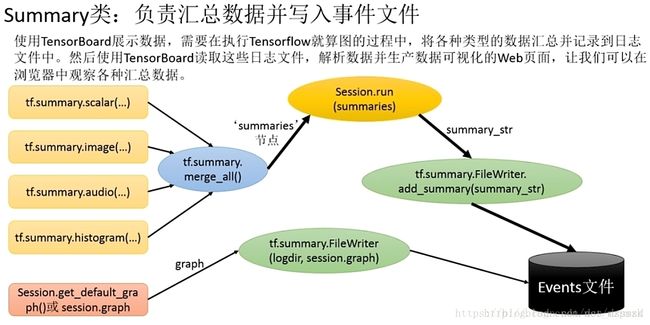tensorboard summary存储数据
利用summary存储数据
- 添加记录节点
tf.summary.scalar(name, tensor) - 汇总记录节点
summary_op = tf.summary.merge_all() - 运行汇总节点
summary_str = sess.run(summary, feed_dict=feed_dict) - 将数据存到文件中
- summary_write = tf.summary.FileWriter(logdir,
graph=sess.graph) - summary_write.add_summary(summary_str, global_step=global_step)
- summary_write = tf.summary.FileWriter(logdir,
可视化显示
tensorboard –logdir=绝对路径
然后在浏览器中打开相应网站,比如http://desktop-45es9ip:6006即可
注意,路径不需要加引号
几个注意事项
global_step 是tensorflow内部会自动维护的变量,在使用时,先用以下代码创建,trainable=False表明此 变量为非训练参数。
global_step = tf.Variable(0, name='global_step', trainable=False)然后将参数传递给optimizer.minimize中的默认参数global_step中,每训练一次,global_step会+1,之后在别的需要此参数的函数调用即可
optimizer = tf.train.GradientDescentOptimizer(learning_rate) train_op = optimizer.minimize(cost, global_step=global_step) # 在后边add_summary函数中调用 summary_write.add_summary(summary_str, global_step=sess.run(global_step))以下代码不可以写在for循环中
summary_write = tf.summary.FileWriter(logdir,graph=sess.graph)
例子
接下来有一个例子,用逻辑回归和三层的神经网络结构来在mnist识别手写体,并将这两天的知识点包含在其中了。
import tensorflow as tf
from tensorflow.examples.tutorials.mnist import input_data
data_dir = 'temp'
mnist = input_data.read_data_sets(data_dir, one_hot=True)
# import pickle
# def load_from_pickle(data_type):
# file_name = '{}.pickle'.format(data_type)
# with open(file_name, 'rb') as f:
# return pickle.load(f)
#
# # load data from disk
# train = load_from_pickle('train')
# validation = load_from_pickle('validation')
# test = load_from_pickle('test')
# train_image, train_label = train['image'], train['label']
# validation_image, validation_label = validation['image'], validation['label']
# test_image, test_label = test['image'], test['label']
def layer(input, weight_shape, bias_shape):
# how to set stddev ?
# the variance of weights in a network should be 2 / n_in,
# n_in is the nummber inputs coming into the neuron
weight_stddev = (2.0 / weight_shape[0]) ** 0.5
w_innit = tf.random_normal_initializer(stddev=weight_stddev)
bias_init = tf.constant_initializer(value=0.)
W = tf.get_variable('W', weight_shape, initializer=w_innit)
b = tf.get_variable('b', bias_shape, initializer=bias_init)
return tf.nn.relu(tf.matmul(input, W) + b)
def inference(x, model=0):
'''
:param x:
:param model: 0 --> logistic regression 1--> multilayer neural network
:return:
'''
if model == 0:
init = tf.constant_initializer(value=0)
W = tf.get_variable('W', [784, 10], initializer=init)
b = tf.get_variable('b', [10], initializer=init)
output = tf.nn.softmax(tf.matmul(x, W)) + b
return output
elif model == 1:
with tf.variable_scope("hidden_1"):
hidden_1 = layer(x, [784, 256], [256])
with tf.variable_scope("hidden_2"):
hidden_2 = layer(hidden_1, [256, 256], [256])
with tf.variable_scope("hidden_3"):
output = layer(hidden_2, [256, 10], [10])
return output
def loss(output, y, choice=0):
'''
:param output:
:param y:
:param choice: 0 --> implement by self 1--> call tf implementation
:return:
'''
# implemented by self
if choice == 0:
# cross_entropy
dot_product = y * tf.log(output)
# sum in row
xentropy = -tf.reduce_sum(dot_product, axis=1)
# tf implementation
elif choice == 1:
xentropy = tf.nn.softmax_cross_entropy_with_logits(labels=y,
logits=output)
# mean on every item
loss = tf.reduce_mean(xentropy)
return loss
def training(cost, global_step, learning_rate):
# add to summary
# summary records data used for tensorboard
tf.summary.scalar('cost', cost) # !!!!!!!! 1
optimizer = tf.train.GradientDescentOptimizer(learning_rate)
train_op = optimizer.minimize(cost, global_step=global_step)
return train_op
def evaluate(output, y):
correct_prediction = tf.equal(tf.argmax(output, axis=1),
tf.argmax(y, axis=1))
accuracy = tf.reduce_mean(tf.cast(correct_prediction, tf.float32))
return accuracy
# python script
# parameters
learning_rate = 0.01
training_epochs = 10
batch_size = 1000
display_step = 1
with tf.Graph().as_default():
# mnist data image of shape 28 * 28 = 784
x = tf.placeholder(dtype=tf.float32, shape=[None, 784])
# 0~9 digits recognition => 10 classes
y = tf.placeholder(dtype=tf.float32, shape=[None, 10])
output = inference(x, model=1)
cost = loss(output, y, choice=1)
# create a not trainable variable to record train step
global_step = tf.Variable(0, name='global_step', trainable=False)
train_op = training(cost, global_step, learning_rate)
eval_op = evaluate(output, y)
# record data
summary_op = tf.summary.merge_all() # !!!!!! 2
saver = tf.train.Saver()
with tf.Session() as sess:
summary_write = tf.summary.FileWriter("logs",
graph=sess.graph) # !!!!!!!!!!!! 3
init_op = tf.global_variables_initializer()
sess.run(init_op)
# training cycle
for epoch in range(training_epochs):
avg_cost = 0.
total_batch = int(mnist.train.num_examples / batch_size)
# loop over all batches
for i in range(total_batch):
mbatch_x, mbatch_y = mnist.train.next_batch(batch_size)
# fit training using batch data
feed_dict = {x: mbatch_x, y: mbatch_y}
sess.run(train_op, feed_dict=feed_dict)
# compute average loss
minibatch_cost = sess.run(cost, feed_dict=feed_dict)
avg_cost += minibatch_cost / total_batch
# display logs every 1 epoch step
if epoch % display_step == 0:
val_feed_dict = {
x: mnist.validation.images,
y: mnist.validation.labels
}
accuracy = sess.run(eval_op, feed_dict=val_feed_dict)
print("Validation error: {}".format(1 - accuracy))
## !!!!!!!!!!!!!!! 4
summary_str = sess.run(summary_op, feed_dict=feed_dict)
summary_write.add_summary(summary_str, global_step=sess.run(global_step))
last_global_step = sess.run(global_step)
print("训练次数:", last_global_step)
# saver.save(sess, 'logistic_logs/model-checkpoint', global_step=global_step)
print('optimization finished')
test_feed_dict = {
x: mnist.test.images,
y: mnist.test.labels
}
accuracy = sess.run(eval_op, feed_dict=test_feed_dict)
print("Test Accuracy:{}".format(accuracy))
summary_write.close()
